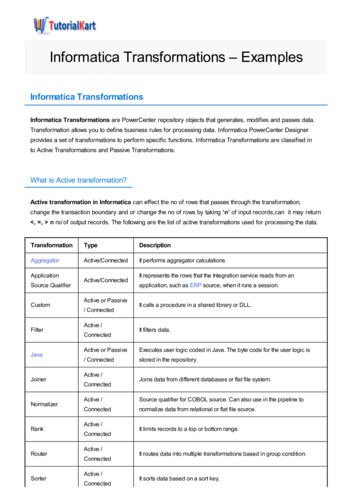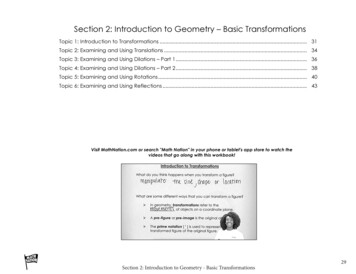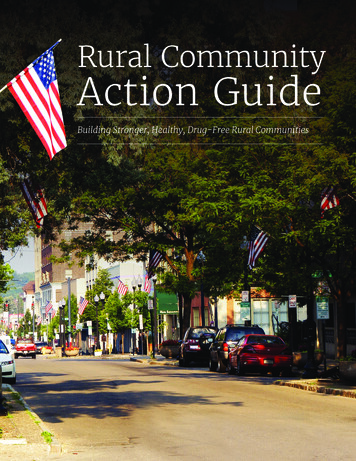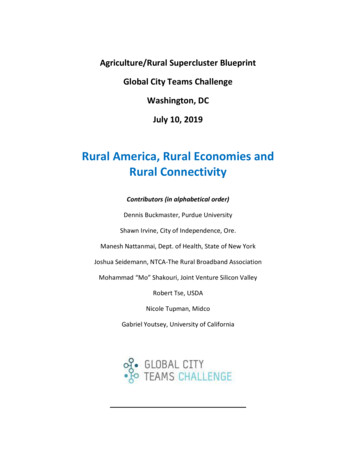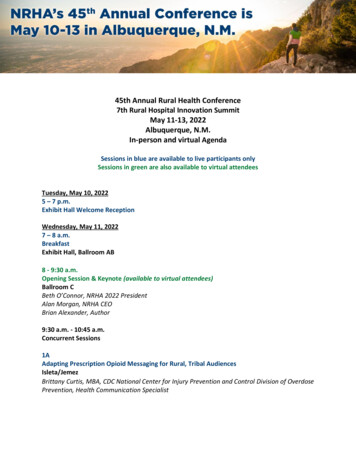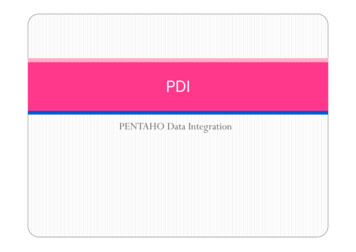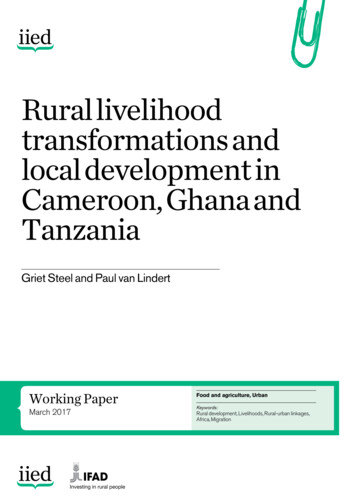
Transcription
Rural livelihoodtransformations andlocal development inCameroon, Ghana andTanzaniaGriet Steel and Paul van LindertWorking PaperMarch 2017Food and agriculture, UrbanKeywords:Rural development, Livelihoods, Rural-urban linkages,Africa, Migration
About the authorsAcknowledgementsGriet Steel, post-doctoral research, Land Governance for Equitableand Sustainable Development (LANDac), The Netherlandsand International Development Studies, Department of HumanGeography and Spatial Planning, Utrecht University. Correspondingauthor: g.steel@uu.nlThis research is part of the four-year collaborative research projectAfrican Rural-City Connections (RurbanAfrica) that finished in2016. RurbanAfrica was funded by the European Union under the7th Research Framework Programme (FP7) for Socio-economicSciences and Humanities (SSH). This working paper summarisessome of the main outcomes of Work Package 2 on rural livelihoods,income diversification and mobility and draws on four reports(see http://rurbanafrica.ku.dk). RurbanAfrica is an internationalcollaborative research project. We are especially grateful to ourcolleagues who took part in field studies in Cameroon, Ghana andTanzania and in the subsequent analysis and reporting phases:D Azemao, F Bart, A Blache, R Bénos, T Birch-Thomsen, B Charleryde la Masselière, I Cottyn, B Daniel, L Douanla, N Essah, N Fold, RFrempong, C Kaffo, M Kuete, S Kelodjoue, E Lazaro, N Lemoigne,J Lukumay, E Mbeng, M McLinden Nuijen, F Mishili, L Msese, TMynborg, G Nijenhuis, T Niyonzima, C Nzeket, S Ørtenblad, R Osei,G Owusu, J Pasini, S Racaud, R Santpoort, J Schapendonk, BThibaud, N Tofte Hansen, M Tsalefac, L Uwizeyimana, R Vos andL Yaka.Paul van Lindert, associate professor, International DevelopmentStudies, Department of Human Geography and Spatial Planning,Utrecht University.Produced by IIED’s Human SettlementsGroupThe Human Settlements Group works to reduce poverty andimprove health and housing conditions in the urban centres ofAfrica, Asia and Latin America. It seeks to combine this withpromoting good governance and more ecologically sustainablepatterns of urban development and rural-urban linkages.About our partnersThis research was funded by the International Fund for AgriculturalDevelopment (IFAD). The views expressed do not necessarilyreflect those of the donors. IFAD invests in rural people,empowering them to reduce poverty, increase food security,improve nutrition and strengthen resilience. Since 1978, IFAD hasprovided about US 16.6 billion in grants and low-interest loans toprojects that have reached some 445 million people. IFAD is aninternational financial institution and a specialised United Nationsagency based in Rome – the UN’s food and agriculture hub.Published by IIED, March 2017Steel, G and van Lindert, P (2017) Rural livelihood transformationsand local development in Cameroon, Ghana and Tanzania. IIED,London. http://pubs.iied.org/10811IIEDISBN 978-1-78431-454-5Printed on recycled paper with vegetable-based inks.International Institute for Environment and Development80-86 Gray’s Inn Road, London WC1X 8NH, UKTel: 44 (0)20 3463 7399Fax: 44 (0)20 3514 oad more publications at http://pubs.iied.orgIIED is a charity registered in England, Charity No.800066and in Scotland, OSCR Reg No.SC039864 and a companylimited by guarantee registered in England No.2188452.
IIED WORKING PAPERThis working paper explores the importance oflivelihood diversification and mobility in livelihoodtransformation processes in dynamic rural areas ofsub-Saharan Africa. It focuses on poverty dynamics,food security and local development. Based onempirical research conducted in Cameroon, Ghanaand Tanzania, the study shows that improvedconnectivity is a major driver of rural livelihoodtransformations and local development in thesecountries. The transformations in agriculturalproduction systems also create a range of additionalrural non-farm labour opportunities for local people,which in turn stimulate positive socioeconomicdynamics in the region.www.iied.org 3
RURAL LIVELIHOOD TRANSFORMATIONS AND LOCAL DEVELOPMENT IN CAMEROON, GHANA AND TANZANIAContentsList of boxes, figure and tables5Summary61 Introduction81.1 Rural-urban linkages1.2 Aim of the paper1.3 Methods1.4 Structure of the paper88892 Theoretical background102.1 Local development and mobility: a politicalperspective2.2 Migration and development2.3 The role of small towns2.4 Why explore mobility?101111123 Contextual characteristics of the research areas 133.1 Socioeconomic transformations3.2 Changes in local production systems3.3 The impact of changing rural dynamics4 www.iied.org1317174 Livelihood diversification184.1 Livelihood strategies4.2 Livelihood transformations4.3 Summary of key rural livelihood strategies1821225 Inflow and outflow of resources235.1 Goods and services5.2 Capital5.3 Remittances5.4 People5.5 Mobility in social and economic networks23242527296 Conclusions: livelihood transformation andlocal development306.1 Mobility and livelihood diversification6.2 Remittances6.3 Transport infrastructure3032336.4 Information and communication technologies35References36Related reading38
IIED WORKING PAPERList of boxes, figuresand tablesBox 1. Socioeconomic disparities in Mount BamboutosBox 2. Land use in BamboutosBox 3. Agropastoralism transformation among the MaasaiBox 4. The tomato value chain in Northern TanzaniaBox 5. External investments in local developmentBox 6. Use of remittances in TanzaniaBox 7. Bamileke migrants’ homeland investmentsBox 8. Spin-off activities for local developmentBox 9. Village development committees131420212525293133Figure 1. Location of the study sites14Table 1. Contextual characteristics of the study sitesTable 2. Households’ main sources of incomeTable 3. Changes in main economic activity, income and purchasing power over 10 years151922www.iied.org 5
RURAL LIVELIHOOD TRANSFORMATIONS AND LOCAL DEVELOPMENT IN CAMEROON, GHANA AND TANZANIASummaryThis working paper analyses livelihood transformations and rural-city connectionsin sub-Saharan Africa to identify some key policy areas for rural development.The empirical analysis builds upon qualitative fieldwork conducted in Cameroon,Ghana and Tanzania in eight different research sites. One common feature ofthe research sites is that each is a dynamic rural region in which transformationprocesses are guiding everyday life of rural households. Building on a wide rangeof empirical examples from these dynamic rural regions, the paper further analysesthe general processes shaping rural transformation and rural-urban connections(which refer to multifaceted flows of people, goods, labour and capital). It aims toanswer the following research question: how do rural-city connections and livelihooddiversification contribute to local development processes in sub-Saharan Africa?A large improvement in rural connectivity such as throughtechnological infrastructure has contributed to increasedmobility dynamics from, to and within the regions. Migrationcannot be considered a unidirectional movement fromrural areas to cities. It has instead been shaped by achain of connections in which rural and urban livelihoodsinteract on a movement continuum. Temporary movement– whether daily, weekly or seasonally – characterises themain mobility pattern of rural households crisscrossingthe region for social reasons as well as to search foremployment, services, commercial goods and education.These temporary flows of people are complemented andlinked with more permanent flows of mobility which makesthe areas under study highly dynamic in terms of mobilityinflows and outflows.These rural dynamics have influenced developmentprocesses in the region in significant ways. The introductionof cash crops has for instance drawn a variety of tradersand external actors who have turned the sites into attractivelocations for investment. Several sites attract traders,businessmen and women who want to invest in land andcreate additional labour opportunities for local people. Inturn, these rural people have a better income through whichthey can afford to travel to town, to cities or other rural areasto look for additional livelihood opportunities. Others starta business in the community; they open a small shop or aphone booth or buy a Chinese motorbike and become ataxi driver. People also invest in improved housing. Theseinvestments in real estate also create a vibrant market forbuilding materials and informal jobs in the constructionsector.In addition, remittances are an important factor incontributing to local development. Especially in Ghana andCameroon, remittances form a significant part of household6 www.iied.orgincome. Most households engage in mobility as partof livelihood survival or consolidation strategies. Theyuse remittances to buy various goods including farminginputs such as fertiliser, as well as cooking utensils,food supplies, cloth, bicycles or small solar panels topower lights at night and to charge mobile phones. Onlya minor few succeed in accumulating wealth as a resultof international remittances. When migrants organisethemselves through hometown or migrant associations,remittances have the potential to be used for localdevelopment projects in infrastructure and services,especially when lobbied for at the national governmentlevel as in the case of Cameroon.However, these positive economic dynamics alsotrigger challenges in terms of local rural development.At the household level, increased mobility of householdmembers places an extra burden on family labour.Sometimes, households must reduce or even stopfarming activities – making them more dependent onexternal money flows. Financial investments in householdmobility can also reduce the availability of cash for dailyneeds.At the community level, not everyone benefits to the sameextent from dynamic rural transformations in the area.Certain population groups are very vulnerable. Fertileland becomes scarce in these regions. In addition, thelack of government support for large-scale investment ininfrastructure and regional planning leaves villages highlydependent on private investments and the ‘goodwill’ oflocal elites and chiefs to initiate development projects.These are often driven by local power games. Theavailability of funds and resources can be unpredictableand unreliable. For success, local development initiativesshould be further embedded in governmental structures.
IIED WORKING PAPERThe paper includes policy recommendations in relation tomobility, livelihood diversification and local development.Positive government-led measures could foster local andregional development in sub-Saharan Africa – recognisingthat current processes of livelihood transformation andmobility dynamics are essential not only for individualhouseholds’ livelihoods, but also for societal developmentat large. In practice, governments could play a vital roleby stimulating the construction and upgrading of regionalroads and by investing in information and communicationtechnologies (ICTs). This might allow a broader rangeof actors to participate in the market exchange and tofacilitate market information from towns and cities tovillages. In addition, local governments could create offseason labour opportunities by employing people in roadmaintenance, construction work or service provision. Suchinstitutionalised, off-season employment opportunitieskeep labour and economic activities in the region – and assuch can foster economic vitality the whole year round.www.iied.org 7
1RURAL LIVELIHOOD TRANSFORMATIONS AND LOCAL DEVELOPMENT IN CAMEROON, GHANA AND TANZANIAIntroduction1.1 Rural-urban linkagesIn sub-Saharan Africa, rural-urban linkages andinteractions play an increasingly significant role in localeconomies and livelihood transformation (Tacoli, 2002),and there is an increased need for understanding theimpact of rural-urban linkages on changing livelihoodsboth in rural and urban areas (Bah et al., 2003; Agergaardet al., 2010). Contemporary mobility processes in subSaharan Africa are increasingly complex due to domesticpost-independence transformations in demography,urbanisation and policies – as well as processes ofeconomic and cultural globalisation which increasinglyconnect Africa to different parts of the world. While ruralurban migration is still a crucial component of the mobilitypatterns in sub-Saharan Africa, mobility flows withinrural areas are also of significant importance in shapingrural livelihoods. More and more people living in ruralareas travel to small towns and service centres in searchof consumer goods, services and labour opportunities.In addition, there are significant urban-rural flows – forinstance, urban residents who, either on a regular orirregular basis, seek livelihood opportunities in ruralareas or engage in rural- (or non-urban) based activities.A growing number of people living in urban areas areinvolved in farming activities in dynamic agriculturalareas because they see opportunities. These are urbandwellers who farm alongside working in their professionsin the city. They rent land in the rural hinterlands andcultivate in agriculturally dynamic places.In general, rural areas have become attractive investmentdestinations due to increased agricultural and nonagricultural opportunities as well as better basicinfrastructure and services that were formerly only foundin cities. This is why certain rural dwellers decide to stayon and even return to the farm to relate to agriculturaldynamics in the region. On the other hand, rural dwellers8 www.iied.orgremain connected to cities but also neighbouring urbancentres, towns and service centres. Mobility flows in theregion are thus no longer one way, but constitute verycomplex and fragmented processes of inflow and outflowof people, money, information, goods and services.1.2. Aim of the paperIn this paper, a variety of mobility flows in rural areas inCameroon, Ghana and Tanzania are analysed in orderto gain an in-depth understanding of rural livelihoodtransformation processes and their impact on local andregional socioeconomic development. To this end, ananalysis of rural dynamics in eight different research sitesin Cameroon, Ghana and Tanzania will be presented (seeFigure 1). In Cameroon, research areas include MountBamboutos, the Moungo corridor and the Noun region.In Ghana, two study sites were selected: these includethe Ahanta West district and the Kwaebibirem district.In Tanzania, focal points are the Kilwa district (referred toas ‘the Lindi case’) and the Njombe and Wanging’ombedistricts (referred to as ‘the Njombe case’). A third researchregion in Tanzania is composed of various districts(Ngorongoro, Monduli and Karatu) in the Maasai landsof the Northern border region; here referred to as ‘theNorthern Corridor’. One common feature of the researchsites is that each one is a dynamic rural region in whichtransformation processes are guiding everyday life ofrural households. However, the regions are very diversein their geographical settings, in the processes drivingtransformation, and in socioeconomic challenges andopportunities, among others.1.3 MethodsIt is through a triangulation of research methods thatthe paper aims to gain a better understanding of theparticularities and similarities in livelihood transformation
IIED WORKING PAPERand rural development processes in sub-Saharancountries. Empirical research was conducted in twophases.In the first stage, a household questionnaire was designedwith the intention to scrutinise livelihood transformationsin relation to rural-city connections by gathering dataon household characteristics, expenditure and savings,migration/mobility and remittances, as well as agricultural,livestock and other household assets. The main goal ofthe household survey was to analyse how these livelihoodactivities and rural dynamics have changed over thepast 10 years. With a reference period of 2004 to 2014,the household members were asked questions aboutdifferences in their livelihood assets and their overallsocioeconomic situation. Only in the Northern Corridorof Tanzania a different methodology was used than in theother research sites. Data on the Northern Corridor arebased on ethnographic research in which interviews andparticipant observation are combined.the research areas on the basis of focus group discussions.To collect the migration narratives (at the household level),mobility maps were used as a tool to both structure theinterviews and to provide a visualisation of the mobilitypatterns of a household. For the local diagnosis (at thesettlement level), the analysis focused on emerging urbancentres in each of the research areas in which focus groupdiscussions as well as interviews with key stakeholderswere conducted. This latter method allowed insight intothe perspective of local investors, business people andgovernmental stakeholders on the subjects of mobility andrural-urban connections.1.4 Structure of the paperThe paper is structured into six sections. Section 2presents the theoretical background to this study. Section3 examines the socioeconomic context of the different sitesin the three countries under study. Section 4 analyses themain processes of livelihood diversification in the studyregions. Mobility patterns are explored in Section 5, whichIn the second research stage, the data of the householdsurvey were completed with the collection of empirical data gives an account of the inflow and outflow of goods andservices, capital, remittances and people. The final sectionthrough a standard data collection guide, used in all thedifferent research sites (with the exception of the Northern summarises some of the key findings of the research andfocuses on the mutual relationship between livelihoodCorridor in Tanzania), recording migration narratives andthrough a diagnosis of the main functions of settlements in transformation and local development.www.iied.org 9
2RURAL LIVELIHOOD TRANSFORMATIONS AND LOCAL DEVELOPMENT IN CAMEROON, GHANA AND TANZANIATheoreticalbackgroundAlthough migration in sub-Saharan Africa is an age-oldphenomenon, it shows increasing complexity in termsof spatial and time dimensions. Rural-urban linkagesand interactions especially tend to play a significantrole in local economies and livelihood transformations(Tacoli, 2002). As such, there is an increased need tounderstand this rural-urban interface and its impact onchanging development processes. Toward this end, thistheoretical framework examines the major changes in thedevelopment landscape of sub-Saharan Africa by focusingon the role of mobility – and more specifically domesticmobility – in transforming local development processes.This section begins with a contextual sketch of the majorpolitical changes that are shaping the main developmentprocesses on the continent. Thereafter, the theoreticaldebate on the migration-development nexus is introduced.Finally, this migration-development nexus is furtherelaborated by linking it to the role of remittances and smalltowns in local development processes.2.1 Local developmentand mobility: a politicalperspectiveOver the past three decades the context of local economicdevelopment in Africa has changed radically. As Helmsing(2001) indicates ‘Up till the nineties, local developmentconditions were shaped by central government agencies,the lives of peasant farmers depended on parastatalagencies that provided or were supposed to provide keyinputs (such as seeds, fertilisers and extension)’. Duringthis time, little was left to the market and peasant autonomywas somewhat limited to decisions about whether or notto grow cash or subsistence crops (Helmsing, 2001). Thecrisis of the 1970s, however, forced many African nations10 www.iied.orgtowards debt relief provided by international financialinstitutions. This led to policies that are predominantlycharacterised by the neo-liberal agendas of the WorldBank, IMF and Western governments. These measureshave had a profound impact on African economies, politicalsituations and hence, population movements (Rakodi,1997; Potts, 1995; 2008; Tacoli, 1998; Adepoju, 2008aand 2008b; Beauchemin, 2011). The impacts of structuraladjustment influence different migration patterns andlocations. For urban areas, some argue a reduction ofin-migration as a response to urban economy declineswhile others see a continuance of rural to urban flows(Beauchemin and Bocquier, 2004; Bocquier, 2004;Potts, 2008). For some, privatisation policies and publicexpenditure reductions have encouraged informal and nonlabour migration mostly from rural to urban areas (Kanaan,2000).The impacts of structural adjustment have also affectedrural regions and small urban centres (Simon, 1992).While public expenditure cuts generally had detrimentaloutcomes, the promotion of small-scale business andaccess to credit has been more beneficial. In Tanzania,smaller urban centres, where growth has its roots in thevalue chain of one dominant crop, developed as tradeliberalisation began to attract investments across a broaderscope of activities. Liberalisation policies, which reducedoutput as well as employment in certain industries, may alsohave encouraged a return migration to rural areas (Simon,1992; Gubry et al., 1996; Potts, 2008). Finally, the requirednational currency devaluation boosted exports and as suchpulled people back into Africa’s main export sectors ofagriculture and mining; these sectors are largely located inrural areas (Riddell, 1997; Beauchemin, 2011).From the 1990s, decentralisation reforms also have had aninfluence on local development processes on the Africancontinent. With a divestment of central economic and
IIED WORKING PAPERof nation state boundaries, because this is the onlyexplicitly and clearly defined feature of transnationalism’.Especially in African migration studies, partly due to thefact that African migration is often considered a ‘policyproblem’ by governments in the global North, thereseems to be a tendency to focus on transnational andeven transcontinental migration (eg Grillo and Riccio,2004; Adepoju, 2008b). With such research bias, thefact that domestic migration is much more significant interms of numbers and volumes compared to internationalmovements (eg Adepoju, 1998; Deshingkar and Grimm,2004; Bryceson et al., 2003; Castaldo et al., 2012) is easilyoverlooked (King et al., 2008). Similarly, more attentionshould be paid to South-South migration as the majorityof African migrants who cross international borders moveWithin this context of neo-liberalisation andto neighbouring countries and so remain on the Africandecentralisation, Helmsing (2001) describes two maincontinent (Fischer and Vollmer, 2009; Spaan and vanimplications for local economic development in Africa. First,Moppes, 2006).as a result of declined development aid, local resourceRemittances form the most tangible link betweenmobilisation has become very important toward financingmigration and development and it is generally believedpublic and collective investments. Second, due to thethat remittances hold great potential for sustainablespace-shrinking effects of technologies in transport anddevelopment and poverty reduction. A large portion ofcommunication as well as the growing mobility of people,capital and firms across (parts of) the globe, socioeconomic migrants send remittances back to their places of origin.disparities between different locations are likely to increase Major attention is always given to flows of internationalmigration which have been rising in parallel with export(Helmsing, 2001: 62). In the following section, the impactearnings and official overseas development assistance.of these changes in the local development framework willDomestic remittances are, however, believed to be farbe further elaborated through a focus on the link betweenmore significant in terms of poverty reduction potentialmigration and development.as flows tend to include more of the very poor (Brycesonet al., 2003; Deshingkar and Grimm, 2004). Whileinternational remittances can be estimated on the basis oftransfers through formal channels, estimates of domesticremittances are very rare to non-existent.With the introduction of the livelihoods approach, a growingrecognition of the dynamic and multi-dimensional nature of Another way migration can contribute towards localdevelopment is through the organisation of diaspora. Thismigration and development has emerged; households inhas been the research context of international migration,fact use all sorts of social and material assets to constructspecifically the participation in co-development initiativestheir livelihoods within a broader socioeconomic andas a new channel for development cooperation (Nijenhuisphysical context (Carney, 1998). To build and sustainand Broekhuis, 2010). Although some of these migranta livelihood, people attempt to gain access to five typesassociations do have a domestic variant, there is still a gapof capital assets (natural, human, social, cultural andin research that considers the existence and contributionsproduced), which they combine and transform in differentof migrant organisations and initiatives in the nationalways (Bebbington, 1999). With this kind of attention paidcontext. Some pioneering work in the African contextto asset access, the livelihoods perspective has beenshows that domestic migrant associations can play aappreciated for focusing on what people have rather thanon what they lack, and on the agency of poor people (Kaag significant role for small and medium towns (Tacoli andSatterthwaite, 2002) as they can positively contributeet al., 2004; Ellis, 1998; Bebbington, 1999; de Haan andto public infrastructure and services that are generallyZoomers, 2005).lacking, such as roads, bridges, schools and health centresLivelihood studies have, for instance, focused on multi(Beauchemin and Schoumaker, 2009).locality and migrants’ active use of geographical scale asa resource though spatially dispersed livelihood strategies(Bebbington and Batterbury, 2001). However, thereseems to be a bias on the role of transnationality in theseThe world is urbanising at a rapid pace, yet the majority ofstudies. Olwig and Sørensen (2002: 2) point out that,urban populations reside in towns and small and medium‘The very diffuseness of the notion of transnationalismcities with less than one million inhabitants (UN Habitat,may narrow the field of investigation to movements and2010; Satterthwaite, 2007). Therefore, policymakersnetworks of relations that involve the bodily crossingas well as academics have a renewed interest in the roleadministrative power to the lower governing levels, thesereforms renewed interest in regional development andthe role of small and intermediate urban centres (Tacoli,1998). Decentralisation reforms also had a positiveinfluence on rural development because infrastructuraland service points were placed closer to rural areas.Additionally, decentralised local governance systemsare key in supporting positive rural-urban linkages. Landpolicies and agricultural transformation are impacted byboth liberalisation measures and public regulation. Throughthe liberalisation of regulatory instruments, new land-tenuresystems were put into place which can ensure security oftenure on one hand and large-scale foreign investments onthe other.2.2 Migration anddevelopment2.3 The role of small townswww.iied.org 11
RURAL LIVELIHOOD TRANSFORMATIONS AND LOCAL DEVELOPMENT IN CAMEROON, GHANA AND TANZANIAof small towns in regional development processes inthe global South, especially over the past two decades(Hinderink and Titus, 2002; Satterthwaite and Tacoli,2003; Owusu, 2008; Bell and Jayne, 2006). Whilethere is no international consensus on the definition ofsmall towns (Nel et al., 2011) and definitions vary widelybetween nations, in general small towns are considered tobe regional service centres that maintain strong and directconnections with their rural hinterlands.and can give shape to a flourishing regional economy(Satterthwaite and Tacoli, 2003).However, Hinderink and Titus (2002) challenge theseoptimistic assumptions on the basis of a comparativeanalysis in Africa, Asia and Latin America showing that therole of small towns in regional development processesis highly dependent on the national and regional politicalcontexts. They argue that general conclusions on smalltowns’ role in economic development cannot be drawnIn the Latin American literature, some debate has occurred without paying attention to context-specific peculiaritiesover the potential for small and intermediate cities toand the specific functions small towns have in the broadercontribute to prosperous urban development (van Lindertregion. This aligns with the argument of Berdegué and hisand Verkoren, 1997; Bolay and Rabinovich, 2004; Herzog, co-authors (2014) who show that only small cities with2006; Klaufus, 2010; Steel, 2013; Berdegué et al., 2014). strong linkages with the rural hinterland have the potentialIn the African context, the debate on the role of small towns to contribute to poverty reduction. Although some townsin regional and rural development is ongoing but tendsoperate as distribution centres for services, facilitiesto embrace a positive stance (Owusu, 2006). Tacoli andand infrastructure, other small towns explicitly functionSatterthwaite (2002) ascribe four potential roles for smallas market centres that link local producers to nationaland intermediate centres in local development processesand international markets. The function of small towns isin Africa. They argue that small cities can ‘act as centresthus a critical factor in their potential contribution to localfor the production and distribution of goods and servicesdevelopment processes and as such deserves moreto their rural region, act as markets for agricultural produce attention in empirica
4.1 Livelihood strategies 18 4.2 Livelihood transformations 21 4.3 Summary of key rural livelihood strategies 22 5 Inflow and outflow of resources 23 5.1 Goods and services 23 5.2 Capital 24 5.3 Remittances 25 5.4 People 27 5.5 Mobility in social and economic networks 29 6 Conclusions: livelihood transformation and local development 30
